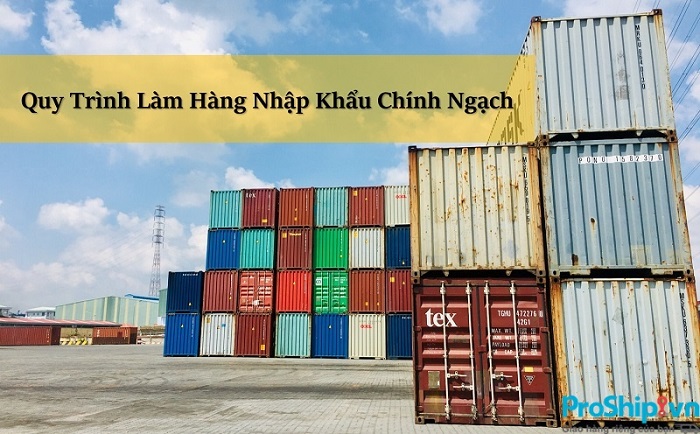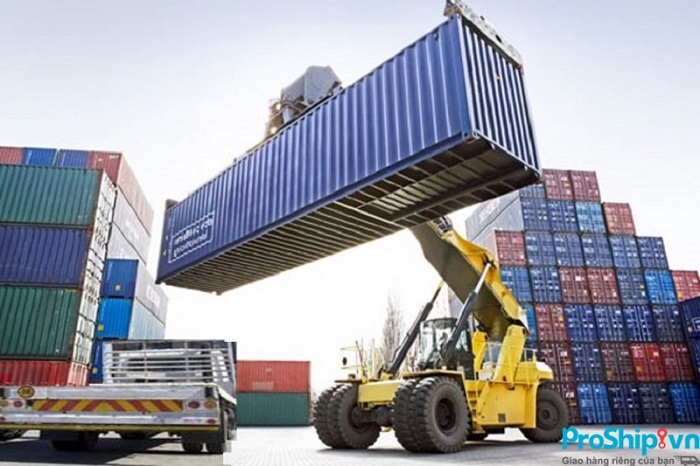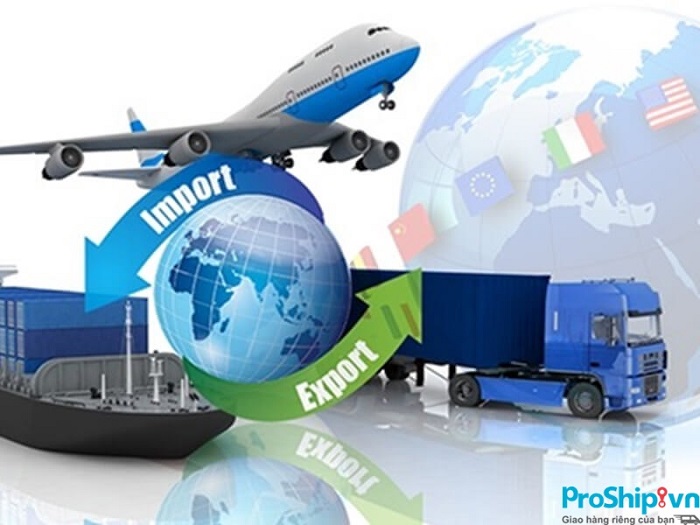* Bạn đang gặp khó khăn trong quá trình xuất nhập khẩu hàng hóa?
* Bạn cần biết các thủ tục xuất nhập khẩu hàng hóa tại Việt Nam hiện nay?
* Bạn chưa biết hiện đơn vị nào nhận làm thủ tục nhập khẩu hàng hóa nhanh, uy tín, giá rẻ?
Những thủ tục nhập khẩu hàng hóa về Việt Nam, thủ tục xuất khẩu hàng hóa từ Việt Nam sang các thị trường khác sẽ được chỉ ra, khách hàng có nhu cầu thực hiện quá trình giao thương hàng hóa nên tham khảo để nắm rõ. Mọi thắc mắc của bạn đặt ra ở trên cũng sẽ được Proship giải đáp, giúp các Doanh nghiệp xuất nhập khẩu hàng hóa dễ dàng lựa chọn một đơn vị uy tín, chất lượng giá tốt nhất thị trường.
XEM THÊM: Vận tải Container giá rẻ
📦 Hotline Liên Hệ Vận Chuyển
🧭 Miền Trung
Những thủ tục xuất, nhập khẩu hàng hóa tại Việt Nam được thực hiện ra sao?
Các thủ tục nhập khẩu hàng hóa, thủ tục xuất khẩu hàng hóa sang các nước được tiến hành như sau:
Thủ tục hải quan nhập khẩu hàng hóa
Trước tiên, tiến hành đàm phán để ký hợp đồng mua hàng với đối tác nước ngoài. Sau đó, hai bên có thể cùng nhau thỏa thuận để thống nhất những điều kiện liên quan, trong hợp đồng sẽ có một số mục điều khoản chính như sau:
- Tên hàng/mã hàng
- Quy cách hàng hoá
- Số lượng/trọng lượng hàng hoá
- Giá cả
- Cách đóng gói
- Điều kiện giao hàng (CIF, FOB, EXW,..)
- Thời gian giao hàng
- Chứng từ hàng hóa từ đối tác kinh doanh.
Đối với các mặt hàng nhập khẩu theo điều kiện CIF, FOB và CNF, nhà nhập khẩu hàng hóa phải làm thủ tục hải quan tại Việt Nam. Đối với công việc này, bạn có thể tự thực hiện hoặc thuê công ty dịch vụ thông quan làm thay. Còn nếu hàng hóa của bạn được nhập vào với điều kiện DDU, DDP (hoặc DAP) thì người bán sẽ làm thủ tục cho bạn và chuyển hàng về kho cho bạn. Và để thực hiện được công việc này, bạn phải cung cấp được những chứng từ cần thiết để kê khai hải quan.
Để thực hiện được bước làm thủ tục hải quan nhập khẩu hàng hóa. Bạn cần phải có bộ chứng từ để làm được hồ sơ hải quan. Thông thường, sau khi hàng của bạn được xếp lên tàu tại cảng nước ngoài. Người bán hàng sẽ gửi cho bạn một bộ chứng từ gốc bao gồm:
- Bộ vận tải đơn (Bill of Lading): 3 bản chính
- Hóa đơn thương mại (Commercial Invoice): 3 bản chính
- Bản kê chi tiết hàng hóa (Packing List): 3 bản chính
- Giấy chứng nhận xuất xứ (CO – Certificate of Origin): có thể theo mẫu D, E, AK,…để được hưởng ưu đãi về thuế nhập khẩu
- Ngoài ra, còn một số giấy tờ khác như: Chứng nhận chất lượng (CQ), chứng nhận phân tích (CA), đơn bảo hiểm, hun trùng, kiểm dịch,…(nếu có).
Hiện nay, bạn có thể thực hiện việc kê khai hải quan qua các phần mềm hải quan điện tử. Sau đó, bạn in tờ khai cùng bộ chứng từ giấy để đem đến chi cục hải quan. Tùy theo kết quả truyền tờ khai là luồng xanh, luồng vàng hay luồng đỏ mà bộ chứng từ đầy đủ như trường hợp tờ khai luồng vàng. Trong trường hợp luồng vàng, hồ sơ hải quan bao gồm:
- Bộ tờ khai hải quan và phụ lục: 2 bản
- Hóa đơn thương mại: 1 bản sao
- Vận đơn: 1 bản sao
- Hóa đơn cước biển (với điều kiện FOB): 1 bản sao
- Các chứng từ khác: CO, kiểm tra chất lượng (nếu có),…
Sau khi chuẩn bị đầy đủ, bạn đem hồ sơ đến chi cục hải quan làm thủ tục và nộp thuế để được thông quan. Tiếp theo, bạn xuống cảng đổi lệnh và trình ký hải quan cổng, bãi. Bước cuối cùng trong thủ tục nhập khẩu hàng hóa tại Việt Nam là chuyển hàng hóa về kho. Sau khi làm thủ tục hải quan, bạn phải chuẩn bị và bố trí các phương tiện vận tải bộ để đưa hàng về kho của mình.

Thủ tục hải quan xuất khẩu hàng hóa
Bước 1: Kiểm tra hàng hóa xuất khẩu
Tương tự như nhập khẩu, đối với xuất khẩu bước này cũng cực kỳ quan trọng. Hàng hóa xuất khẩu cũng chịu sự quản lý của Nhà nước nên bạn cần kiểm tra lại xem:
- Hàng hóa của bạn có thuộc danh mục hàng cấm xuất khẩu hay không: Với những loại hàng hóa này, bạn không được phép xuất khẩu ra ngoài.
- Hàng của bạn có thuộc danh mục hàng xuất khẩu có điều kiện hay phải xin giấy phép hay không: Với những mặt hàng này, thủ tục xin khá phức tạp và mất nhiều thời gian, do đó, tùy thuộc vào năng lực, bạn cần phải tự cân nhắc có nên xuất khẩu những mặt hàng này không.
- Hàng phải kiểm tra chuyên ngành: Quy định hàng nào phải kiểm tra chuyên ngành phụ thuộc vào quy định của từng bộ ngành nên bạn cần kiểm tra thật kỹ trước khi xuất khẩu.
Bước 2: Lựa chọn thị trường xuất khẩu và đối tác
- Đối với các doanh nghiệp xuất khẩu, việc lựa chọn thị trường xuất khẩu đóng vai trò rất quan trọng trong việc quyết định thành bại trong kinh doanh. Khi nghiên cứu thị trường nước ngoài, bạn cần tập trung vào một số vấn đề như: dung lượng thị trường, nhu cầu về sản phẩm, điều kiện về chính trị, kinh tế, xã hội, luật pháp,…
- Đối với các đối tác bạn cần quan tâm đến hình thức tổ chức của đối tác, khả năng tài chính, uy tín của đối tác, lĩnh vực ngành nghề kinh doanh và thiện chí của họ,…Sau khi đánh giá các yếu tố trên, bạn sẽ quyết định được thị trường và đối tác nhập khẩu hàng của bạn.
Bước 3: Đàm phán và ký kết hợp đồng
Hiện nay, thực tế các bên trong mua bán quốc tế thường ở các quốc gia khác nhau nên việc đàm phán thông qua gặp gỡ trực tiếp là rất khó khăn. Hình thức đàm phán phổ biến hiện nay là thông qua thư từ điện tín hoặc điện thoại. Quá trình đàm phán sẽ càng thuận lợi cho bạn nếu như trước đó bạn đã chuẩn bị kỹ càng các chiến lược và chiến thuật đàm phán thương mại. Sau khi hai bên đã thương lượng xong, hợp đồng ngoại thương sẽ được ký kết. Đây là một trong những chứng từ rất quan trọng trong thương mại quốc tế.
Bước 4: Xin giấy phép xuất khẩu
Như đã đề cập ở trên, sẽ có một số mặt hàng thuộc danh mục xuất khẩu có điều kiện, do dó trước khi xuất khẩu đi nước ngoài, bạn phải xin giấy phép từ các bộ, ban, ngành có liên quan. Quy trình, thủ tục, giấy tờ và hồ sơ sẽ được quy định cụ thể trong thông tư hướng dẫn của các bộ, các bạn có thể tra cứu trên Internet.
Bước 5: Thuê tàu và lấy Container rỗng
Tùy thuộc vào điều kiện Incoterms mà bạn đã thỏa thuận trong hợp đồng, nếu là nhóm C, D, người xuất khẩu sẽ là người đi thuê tàu, các nhóm còn lại, người nhập khẩu sẽ đi thuê tàu. Thông thường, để việc thuê tàu đạt hiệu quả và tối ưu nhất, các nhà xuất khẩu hiện nay thường đi qua một bên Forwarder, nhờ họ book và làm thủ tục Hải quan.
Nếu bạn là người thuê tàu, sau khi booking, bạn sẽ ra cảng để đổi lấy booking confirmation. Việc này giúp hãng tàu xác nhận được là bạn đã đồng ý lấy container và seal. Nếu người nhập khẩu là người đi thuê tàu, bạn sẽ nhận được transport confirmation và đem đi đổi lấy booking.
Bước 6: Đóng gói hàng, ký hiệu chuyên chở (Shipping Mark)
Từ thông tin trên booking, bạn sẽ kéo cont rỗng về kho của bạn để đóng hàng. Trong quá trình đóng gói, bạn phải ghi đầy đủ thông tin trên lô hàng (shipping mark). Các thông tin thường bao gồm: tên hàng, tên và địa chỉ công ty xuất khẩu, tên và địa chỉ công ty nhập khẩu, xuất xứ, trọng lượng tịnh, trọng lượng bì, các ký hiệu hướng dẫn vận chuyển (hàng dễ vỡ, hàng cồng kềnh,…).
Bước 7: Làm thủ tục Hải quan
Truyền tờ khai Hải quan: Việc truyền tờ khai của hàng xuất cũng tương tự như hàng nhập. Nếu bạn tự làm hết thì nhớ hỏi kinh nghiệm của các anh chị đi trước để tránh mắc phải những sai sót không đáng có nhé. Còn nếu như bạn làm thông qua một Forwarder thì việc này khá đơn giản vì bên này sẽ làm hết cho bạn.
Làm thủ tục xuất khẩu tại các chi cục Hải quan: Sau khi truyền tờ khai Hải quan, hệ thống sẽ cho ra luồng của tờ khai. Tùy thuộc vào luồng khác nhau mà thủ tục cũng có đôi chút khác nhau:
– Tờ khai luồng xanh: Đối với luồng này, tờ khai của bạn sẽ được thông quan luôn mà không cần kiểm tra hồ sơ hay kiểm tra thực tế hàng hóa. Bạn chỉ cần đến Hải quan giám sát nộp chứng từ gồm:
- Phơi hạ hàng
- Mã vạch (in từ website tổng cục hải quan)
- Phí cơ hạ tầng (chỉ áp dụng ở cảng Hải Phòng)
Hải quan sẽ ký nháy và có nơi còn đóng dấu nội bộ ra mặt sau tờ khai, lúc này bạn có thể đem nộp cho hãng tàu.
– Tờ khai luồng vàng: Đối với tờ khai luồng vàng thì Hải quan sẽ kiểm tra hồ sơ của bạn. Tương tự như hàng nhập, nếu Hải quan thấy có sự sai khác hoặc thiếu sót, họ sẽ yêu cầu bổ sung hoặc giải trình. Nếu bổ sung đầy đủ, tờ khai của bạn sẽ được thông quan. Nếu không giải trình được, rất có thể tờ khai của bạn sẽ bị bẻ sang luồng đỏ.
– Tờ khai luồng đỏ: Khi phân vào luồng này, hải quan sẽ kiểm tra thực tế hàng hóa sau khi kiểm tra bộ chứng từ thấy hợp lệ. Kiểm hóa có thể thực hiện bằng máy soi chuyên dụng, hoặc cán bộ hải quan mở container kiểm tra thủ công. Nếu có nhiều lỗi sai nặng, bạn sẽ bị xử lý vi phạm, còn nếu lỗi nhỏ, Hải quan sẽ yêu cầu bạn sửa hồ sơ cho đúng. Sau khi hoàn thành xong quá trình kiểm hóa, tờ khai của bạn sẽ được thông quan.
Thông quan & thanh lý tờ khai: Sau khi tờ khai đã được thông quan và qua hải quan giám sát, bước tiếp là bạn nộp lại tờ khai, mã vạch cho hãng tàu, để họ làm thủ tục xác nhận thực xuất với hải quan giám sát, khi hàng đã lên tàu.

Tại sao phải thuê Dịch vụ hải quan làm thủ tục xuất, nhập khẩu hàng hóa?
Nếu Doanh nghiệp của bạn lần đầu tiến hành thực hiện các thủ tục xuất nhập khẩu hàng hóa, thay vì loay hoay trong mớ giấy tờ thủ tục, làm sai rồi phải làm đi làm lại không biết bao nhiêu lần rất mất thời gian thì hãy nghĩ ngay đến việc tìm thuê Dịch vụ hải quan. Những lý do cụ thể được chỉ ra như sau:
- Thủ tục xuất nhập khẩu phải làm như thế nào?
- Bạn có chắc mặt hàng mình muốn xuất, nhập khẩu có phải là hàng cấm?
- Thuế xuất nhập khẩu có đắt không? Phải nộp thuế như thế nào?
- Chi phí cho tất cả các thủ tục đó là bao nhiêu?
- Hàng hóa xuất nhập khẩu có cần kiểm tra chuyên ngành hay không/ phải tiến hành những bước kiểm tra nào?
- Bạn phải mất bao nhiêu thời gian mới có thể làm xong các thủ tục đó?
- Liệu có vướng mắc thủ tục nào hay không? Hàng hóa có thể đến đúng thời hạn hay không?
Tất cả những câu hỏi trên bạn phải trả lời được và tự thực hiện được nếu muốn quá trình xuất, nhập khẩu hàng diễn ra thuận lợi nhưng nếu bạn không biết các thủ tục nhập khẩu hàng hóa hay xuất khẩu hàng này phải bắt đầu từ đâu, phải làm thế nào mới chuẩn xác thì chắc chắn sẽ vô cùng khó khăn & tốn không ít thời gian. Vậy tại sao bạn không tìm thuê hẳn một Đơn vị chuyên nhận làm Dịch vụ hải quan trọn gói giá tốt nhất?
Và PROSHIP chính là một trong những sự lựa chọn hàng đầu mà các Doanh nghiệp có thể an tâm gửi gắm niềm tin và giao phó trách nhiệm. Bởi chúng tôi đã có rất nhiều năm kinh nghiệm trong việc tiến hành các thủ tục hải quan, đội ngũ nhân viên chuyên trách sẽ giúp khách hàng có được các thủ tục nhập khẩu hàng hóa thông quan nhanh chóng nhất. Tóm lại, khi sử dụng dịch vụ của chúng tôi, khách hàng chỉ cần chờ đợi hàng hóa đến tay mình trong thời gian ngắn nhất, cam kết không chậm trễ tiến độ kinh doanh của bạn.
📦 Hotline Liên Hệ Vận Chuyển
🧭 Miền Trung
Dịch vụ khai báo thủ tục xuất nhập khẩu hàng hóa UY TÍN CHUYÊN NGHIỆP của Proship
Quy trình về chứng từ xuất nhập khẩu và thủ tục hải quan nhìn chung cũng không quá khó khăn, phức tạp. Quan trọng là doanh nghiệp cần thực hiện theo đúng yêu cầu, chuẩn bị đầy đủ các loại hồ sơ theo quy định ban hành, đồng thời tham khảo thêm ý kiến và kinh nghiệm từ những người đã từng thực hiện trước đó nhưng việc chuẩn bị hồ sơ sẽ khiến doanh nghiệp mất nhiều thời gian lẫn công sức. Do đó, nếu Doanh nghiệp của bạn không muốn tốn quá nhiều thời gian vào những thủ tục rườm rà như thế thì giải pháp tốt nhất là hãy cân nhắc sử dụng Dịch vụ ủy thác xuất nhập khẩu tại TPHCM & Hà Nội của Proship chúng tôi.
Với sự am hiểu tường tận về lĩnh vực hải quan – xuất nhập khẩu, nắm rõ tất tần tật mọi quy trình thủ tục hải quan, PROSHIP đã & đang cung cấp Dịch vụ khai báo hải quan trọn gói, đảm trách giao nhận hàng hóa xuất nhập khẩu nhằm hỗ trợ khách hàng thông quan hàng hóa nhanh chóng, đảm bảo công việc kinh doanh của Công ty bạn luôn thuận lợi, suôn sẻ.
Proship nhận được sự tin tưởng từ đối tác, khách hàng nhờ những yếu tố
- Proship có kinh nghiệm lâu năm trong lĩnh vực xuất nhập khẩu
- Chi phí cạnh tranh, thông quan hàng hóa nhanh, hiệu quả
- Nhân viên nhiệt tình, tận tâm, sẵn sàng tư vấn các thủ tục xuất nhập khẩu các loại hàng hóa
- Cung cấp các Dịch vụ xuất nhập khẩu trọn gói để phục vụ nhu cầu khách hàng
- Dịch vụ khai báo thủ tục xuất nhập khẩu hàng hóa uy tín, trung thực và chất lượng hàng đầu.

Dịch vụ khai báo thủ tục nhập khẩu hàng hóa về Việt Nam, xuất khẩu hàng hóa trọn gói của Proship thực hiện các việc
- Kiểm tra bộ chứng từ xuất nhập khẩu
- Xác định mã HS code
- Xác định các loại thuế và thuế xuất nhập nhẩu phải nộp
- Xác định trị giá hải quan đối với hàng hóa
- Lên tờ khai hải quan và hoàn tất thủ tục hải quan tại cửa khẩu
- Giấy phép cho các mặt hàng xuất nhập khẩu có điều kiện
- Kiểm tra chất lượng, kiểm dịch thực vật, hun trùng
- Thanh toán lệ phí hải quan thay mặt khách hàng
- Thủ tục hải quan đối với hàng hoá tạm nhập-tái xuất, tạm xuất-tái nhập
- Thủ tục hải quan đối với hàng nguy hiểm
- Dịch vụ Giấy chứng nhận xuất xứ (C/O),…
Proship.vn vừa giúp khách hàng tìm hiểu về những thủ tục xuất nhập khẩu hàng hóa tại Việt Nam hiện nay, bạn có thể tham khảo để nắm chắc mọi quy trình. Đặc biệt, Proship hiện nhận tư vấn, hỗ trợ khai báo, làm thủ tục hải quan xuất nhập khẩu tại TPHCM & Hà Nội uy tín, đáng tin cậy nhất hiện nay, mọi chi tiết vui lòng liên hệ qua hotline 0909 344 247 để được báo giá nhanh chi tiết nhất nhé.

Cảm ơn admin vì thông tin rất chi tiết. Nhất là đối với những người đang tự học xuất nhập khẩu như mình.
Camr ơn bạn